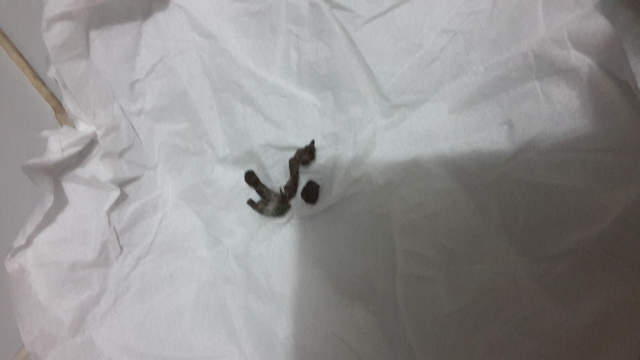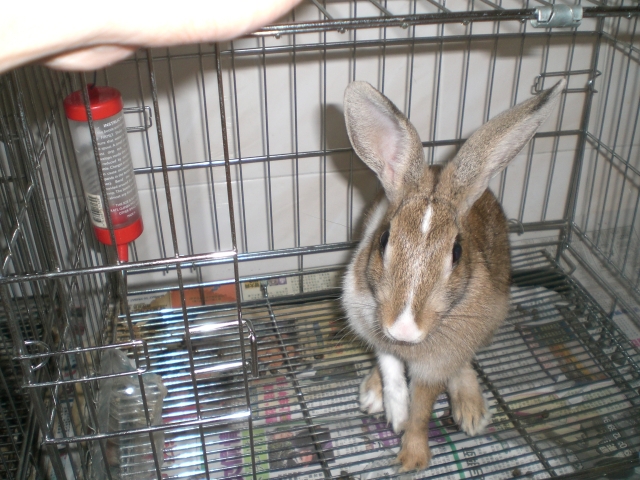Questionafter a stasis in Feb. bun deleloped a 'drunken' walk. We thought it was caused by shot of narcotics etc. that day at vet. Paralysis progressed in hind left leg unit no movement at all. Vet thought e-cuniculi, put on anti-parasitic drug. Still no movement. Added a new baby bun, back in motion. a lot. But no paralysis has spread to front leg on that same side. other side is good. eating and functions okay. Had to separate buns when second hit adolescence. Bjut sick bun seems good, just falls once in a while. He seems to 'carry' his back leg. What do you think?
AnswerHi Kim,
I too suspect E Cuniculi. I have done extensive research on EC as it took a very special rabbit from me far too soon. At that time, nobody knew anything about EC. I have a very personal vendetta against EC.
I have treated many rabbits here with active EC. I have one being admitted tomorrow with advanced EC....she lives with one of my rescue's volunteers (and she is a licensed vet) but will be coming here for more advanced treatment. In reality, very few vets have actually seen an active case of EC much less treated one. Most of the info that vets rely on from reference manuals are woefully inaccurate.
E Cuniculi is a protozoan infection. Nearly every domestic rabbit has been exposed to EC. Most often, it is passed from mom to her babies at birth. It can also be transmitted by contact with urine from an infected rabbit. It is carried sub-clinically until something happens....stress, illness or anything...happens to stress the immune system. The initial presentation of every EC case we have seen here is a "lazy" left rear leg. That is the first neurological marker EC gives you. Most of the time, the leg works find but every once in a while, and it might be very rare....it will appear that the leg "drags" or it might appear the rabbit has forgotten how to use it. Usually appearing soon after the initial paresis of the LR leg will be urinary incontenance. We have seen them be soaked in urine. The urine will be quite concentrated and smelly. Inexperienced vets usually misdiagnose this as a urinary tract infection and associate the lazy leg with the infection. A culture would probably show no unusual bacterial activity.
EC is usually suspected in every case of head tilt or wry neck (technically called torticollis). The fact is that EC is not primarily responsible for tilt. Tilt, in the abscense of head trauma, is almost always caused by a bacterial infection in the middle and/or inner ear. The immune system treats the EC as the highest priority threat and attacks accordingly leaving the door wide open for opportunistic pathenogenic bacteria to enter the picture. With the initial presentation of paresis in the LR, you might notice the symptoms appear to resolve after a short period of time. That is the first response of the immune system trying to protect the body. But the protozoa is too strong and will soon overwhelm the immune system. The neurological and urinary issues will escalate. We usually see "roving" infections in various systems in the body....this week you might be responding to an ear infection, in a couple of weeks maybe a respiratory infection, then eyes and so on. The EC will eventually all but destroy the immune system. The spores that shed from the protozoa also pit and scar the tissues in the kidneys. The increasing damage from the spores will lead to less efficient kidneys and eventually acute renal failure. In every EC case here, for those we eventually lost was due to renal failure. In the advanced stages of EC, there might come a point where a difficult decision must be made. It will become a quality of life issue as the disease matures.
Treatment is difficult. Most vets are using the anti-parsitics....mostly the "bendzoles" with Fenbendazole (Panacur) being the most favored. Unfortunately I have not met with much success with these drugs. They have a nearly impossible task in penetrating the blood/brain barrier....oddly enough, the protozoa has no problem getting thru. When attempting to treat EC with these wormers, dosing is normally once a day for at least 28 days....I have done 60 consecutive days. It didn't show me any benefit as far as the EC. A much more promising treatment I am using now is a drug called Marquis (Ponazuril) that is used to treat a similar condition, Equine Protozoal Myeloencephalitits (EPM) in horses. It is a closely related protozoa. This drug can pass thru the blood/brain barrier in horses....and since horses and rabbits are medically treated a lot alike...this drug should at least arrive at the target. We have seen some benefit from using NSAIDs early in the event in an effort to reduce inflammation in the brain...and hopefully limit the neurological damages....time will tell on that one. Honestly, the best treatment for EC is the rabbit's own immune system. When we suspect EC....we do even more than we normally do to support the immune system.
I would suggest performing a blood panel with EC titer. The titer results can't be taken as "gospel" but is beneficial in being a "piece of the puzzle". Obviously if the lab returns a "high positive" that probably means an active EC infection is in play. I would also suggest doing these labs at regular intervals....maybe ever three months right now....and redo the titer but also chart the kidney function. These labs will be your first clincial indication of how well the kidneys are holding up against the spores. Learn to do sub-q fluids (and learn to do drug injections too) as this will not only open up new avenues of treatment (as compared to oral drugs) and will save the expenses of vet visits on treatments you can do at home. It's just as important to learn when NOT to give fluids as it it to when to give them. Being able to administer fluids will be of major help to the kidneys. Some husbandry modifications will be requied as the neurological issues progress and the rear leg becomes less mobile. I would aggressively pursue treatment as quickly as possible. Good luck.

 bunnys tummy looks so big and hard
QuestionQUESTION: Hai Cat,
I have a bunny is about 1 an
bunnys tummy looks so big and hard
QuestionQUESTION: Hai Cat,
I have a bunny is about 1 an
 Rabbit urinating outside litter box
Question
Very large white male Very large white
Rabbit urinating outside litter box
Question
Very large white male Very large white
 bunnie human bond?
Question
Bunkie
I have a question that has no be
bunnie human bond?
Question
Bunkie
I have a question that has no be
 not hungry bunny
Question
Patchie Baby
I own a rabbit and she is
not hungry bunny
Question
Patchie Baby
I own a rabbit and she is
 Litter pan training/use of bedding/digging?
Question
Bunny Hutch Base Finished Bunny Hutch &n
Litter pan training/use of bedding/digging?
Question
Bunny Hutch Base Finished Bunny Hutch &n